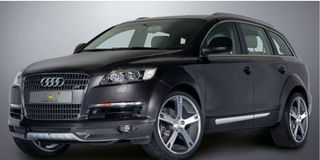What happened to the 2006 Audi Q7?

The Audi Q7 is not common on Ugandan roads probably because it still commands a high price that many people cannot afford. STOCK PHOTO
With its peers Mercedes and BMW having drawn first blood in the SUV market way back in 1998 and 2000 respectively, the Q7 represented Audi’s first stab at the lucrative luxury SUV market albeit being over six years late to the party in 2006. While late, it has paved the way for other sports utility cars bearing the four rings. Make no mistake, the Q7 is a serious piece of automotive real estate and one that often feels big and imposing. But why is it not as popular in the used car market in Uganda as it ought to be?
Exterior
The first generation Q7 came out in 2006 and the shape was kept the same for a long time. This is a good thing as the car looks quite modern 12 years later. The Olympic Audi rings look elegant on the signature grill. This car on the road looks every bit of its 5.1 metre length giving it considerable presence on the road. While this is squarely an SUV, its styling seems to distance it from the traditions of an SUV and for what it is, looks like a MPV like the Toyota Wish on growth hormones.
Interior
Inside the Q7 is all you would expect of an up range Audi from that era. There is commanding driver position with vast interior. This is one of those cars that the exterior size does not paint the whole picture and misrepresents the supposed interior space. The whole interior feels expensively made out of high-quality materials. It is made all the more practical with seven seats as standard in all models, which gives it a versatility. The rearmost seats are not as useful as you would expect in such a monster car as they are really for children only.
Engine and driving dynamics
At first there were just two engines, a 3.0-litre V6 diesel that was in elsewhere in the Audi range, and a powerful but thirsty 4.2-litre FSI petrol unit. You shall only get the diesel if you are buying from Europe otherwise most Q7s from Japan shall be petrol. A 3.6-litre FSI petrol engine arrived at the start of 2007, followed by a 4.2-litre TDI diesel, both better and/or more relevant units than the initial pair. The Q7 is equipped as standard with quattro permanent four-wheel drive. This is a big car so manoeuvrability in tight corners and spaces might be a challenge.
Maintenance
There was a time when many buyers in Uganda loved the Q7, today you shall find none on the road, why? Well I have two theories. One that there are simply better alternatives and two, they are maintenance nightmares that many just parked them and gave up on them. Yes, an over decade old Audi Q7 is quite hard to stomach in repair bills. Worse still there is no authorised dealer; locally maintaining it even harder. Light at the end of the tunnel is that this car shares its platform with the Touareg which has a solid set of customers in Uganda. Chances are that mechanics who work on the VW Touareg can comfortably work on a Q7.
Value
Being a first generation from 2006, in the used car market it still commands a high price, one that many are not willing to stomach as they see better and cheaper offerings. As well, the depreciation curve on this one is extremely steep, another reason for the low buys of this car. If you can get past that, then by all means.
Audi is famous for its quattro four-wheel drive system and has put its expertise to use with the Q7. It is a big car though and this translates into superb passenger space and seven-seats as standard while the air suspension ensures supreme comfort.
Disadvantages
Despite its design as a full-size luxury sport utility vehicle, the lack of a low-range transfer case made the Audi Q7 more suited for on-road use. Adjustable air suspension and a central differential lock were also important off-road-oriented features on the Q7. The ‘Q’ designation on Audi’s new model range was subject to a lawsuit intended by Nissan to the German manufacturer, as its Infiniti marque had also been using the letter ‘Q’ for both sedans and SUVs since the late 80s. The two company reached an agreement later in 2006.
Specs
Engine type. 3.0-liter six-cylinder.
Horsepower (@ rpm) 329 @ 5,500 - 6,500.
Acceleration (0—60 mph) 5.7 seconds.
Torque (lb-ft @ rpm) 325 @ 2,900 -5,300.
Transmission. Eight-speed Tiptronic® with quattro® all-wheel drive.
Towing capacity (lb) 7,700.
Valvetrain. 24 valve DOHC.
Combined MPG. 21 mpg.
www.audiusa.com




